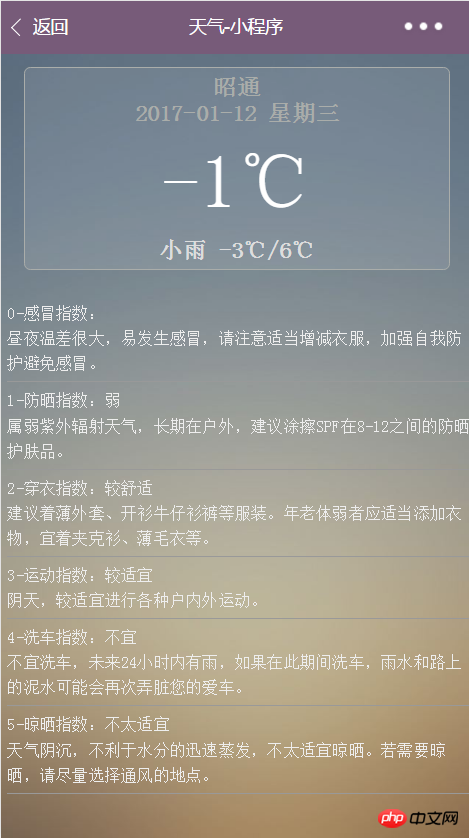微信小程式中天氣預報開發的程式碼
- 不言原創
- 2018-06-27 11:30:413069瀏覽
這篇文章主要介紹了微信小程式天氣預報開發實例代碼源碼的相關資料,這裡含有源碼,需要的朋友可以參考下
微信小程式天氣預報
實例主要功能
自動定位所在城市
#根據所定位的城市取得天氣資訊
#顯示未來幾天的天氣狀況
查看當天天氣的詳情資訊
先看效果圖

微信小程式-天氣首頁

#微信小程式-天氣詳情頁
想法及編碼部份自動定位所在城市
wx.getLocation:透過官方文件的API中可以看到wx.getLocation可以取得到目前的地理位置和速度,不過取得的地理位置只是經緯度,而不是真正的城市名稱,但我們可以根據這個經緯度來獲取城市名稱等資訊(需要用到第三方介面),再透過城市名稱和城市ID取得對應的天氣資訊。
在.js邏輯層增加函數:
data:{
weatherApikey:'', //天气apikey,在http://apistore.baidu.com 上申请
city:'', //城市名称
areaid:'', //城市对应的id
curWd:{}, //当天天气情况
indexs:{}, //当天天气详情说明
forecast:{} //未来4天的天气情况
},
onLoad:function(options){
// 生命周期函数--监听页面加载
this.setData({weatherApikey:getApp().globalData.weatherApikey});
this.loadLocation();
},
//获取当前的位置信息,即经纬度
loadLocation: function() {
var page = this;
wx.getLocation({
type: 'gcj02', // 默认为 wgs84 返回 gps 坐标,gcj02 返回可用于 wx.openLocation 的坐标
success: function(res){
// success
var latitude = res.latitude;
var longitude = res.longitude;
//获取城市
page.loadCity(latitude, longitude);
}
})
},
//通过经纬度获取城市
loadCity: function(latitude, longitude) {
var page = this;
//这个key是自己在http://apistore.baidu.com上申请的
var key = "XSWBZ-EVQ3V-UMLPA-U4TP6-6MQFZ-UUFSL";
var url = "http://apis.map.qq.com/ws/geocoder/v1/?location="+latitude+","+longitude+"&key="+key+"&get_poi=1";
wx.request({
url: url,
data: {},
method: 'GET', // OPTIONS, GET, HEAD, POST, PUT, DELETE, TRACE, CONNECT
// header: {}, // 设置请求的 header
success: function(res){
// success
var city = res.data.result.address_component.city;
city = city.replace("市", ""); //将“市”去掉,要不然取不了天气信息
page.setData({city: city});
page.loadId(city);
}
})
},
//通过城市名称获取城市的唯一ID
loadId: function(city) {
var page = this;
var url = "http://apis.baidu.com/apistore/weatherservice/citylist";
wx.request({
url: url,
data: {
cityname: city
},
header: {
apikey:page.data.weatherApikey
},
method: 'GET', // OPTIONS, GET, HEAD, POST, PUT, DELETE, TRACE, CONNECT
success: function(res){
// success
var cityid = res.data.retData[0].area_id;
page.setData({areaid: cityid});
page.loadWeather(city, cityid);
}
})
},
//通过城市名称和城市ID获取天气情况
loadWeather: function(city, areaId) {
var page = this;
var url = "http://apis.baidu.com/apistore/weatherservice/recentweathers";
wx.request({
url: url,
data: {
cityname:city,
cityid: areaId
},
header: {
apikey: page.data.weatherApikey
},
method: 'GET', // OPTIONS, GET, HEAD, POST, PUT, DELETE, TRACE, CONNECT
success: function(res){
// success
page.setData({curWd : res.data.retData.today, indexs: res.data.retData.today.index, forecast:res.data.retData.forecast});
}
})
},
//事件绑定,跳转到天气详情页面
gotoDetail: function(event) {
// console.log(this.data.areaid+"==在这里跳转=="+this.data.city);
wx.navigateTo({
url: '../detail/detail?city='+this.data.city+"&cityid="+this.data.areaid
})
}
#注意:page.setData或this.setData都是用來設定data中的資料值的。透過上面的邏輯層可以看出在這裡基本上都是處理資料和一些事件綁定,而且微信本身已經為我們封裝了很多實用的功能,這裡用到的比如:wx.navigateTo、wx.request、wx. getLocation,在與視圖通訊時有點類似AngularJS的雙向資料綁定。
index.wxml解析
<view class="main-container">
<import src="../templates/today-tpl"/>
<view bindtap="gotoDetail">
<template is="today-tpl" data="{{city, curWd}}"/>
</view>
<import src="../templates/index-tpl"/>
<view class="index-content">
<block wx:for="{{indexs}}" wx:key="item" wx:for-index="idx">
<template is="index-tpl" data="{{item,idx}}"></template>
</block>
</view>
<import src="../templates/forecast-tpl"/>
<view class="forecast">
<block wx:for="{{forecast}}" wx:key="item">
<template is="forecast-tpl" data="{{item}}"/>
</block>
</view>
</view>
#說明:這裡用到了微信的一些元件,如:view:視圖容器;block:不會在頁面上留下任何東西,循環時使用這個不會增加額外的標籤;template:引用模板;import:導入模板信息,只有導入後才能引用;{{}}:引用數據;wx:for:循環。
範本檔案
範本檔案其實就是wxml檔案
#<template name="today-tpl">
<view class="today">
<view class="city">{{city}}</view>
<view class="date">{{curWd.date}} {{curWd.week}}</view>
<view class="temp">{{curWd.curTemp}}</view>
<view class="weather">{{curWd.type}} {{curWd.lowtemp}}/{{curWd.hightemp}}</view>
<view class="wd">{{curWd.wd}}</view>
</view>
</template>
注意:關於範本的描述可以參考官方文件 模板 和 引用 。
以上就是本文的全部內容,希望對大家的學習有所幫助,更多相關內容請關注PHP中文網!
相關推薦:
以上是微信小程式中天氣預報開發的程式碼的詳細內容。更多資訊請關注PHP中文網其他相關文章!

